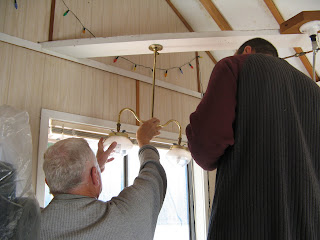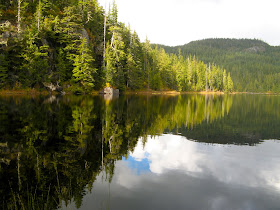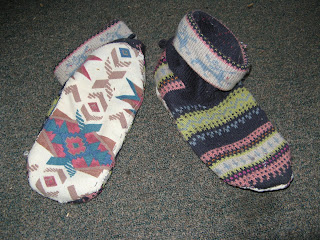
It's
tough in winter to generate enough power with solar panels to run electric lights (even LEDs) for more than a short time each night. Even on a sunny day, at this time of year we only get about two hours of direct light. Our winter alternative is
propane light.
We have a
double chandelier in our kitchen that lights up our great room. It's not bright enough for reading, but plenty to do general tasks.

When we did our kitchen remodel, we had to move the light to make room for the
new propane refrigerator. We asked our good friend John to help us out for two reasons. One, he has the proper tools, and two, he knows what he's doing. Propane is a safe energy source if it is used carefully. The primary danger is a leak, allowing propane to sink and collect in low areas, creating a fire and explosion hazard.

Propane is odourless, but an additive gives it a “rotten egg” smell to warn if there's a leak. Good thing! The new position for the chandelier was just far enough away to require an extension of copper tubing and a new fitting. A dab of liquid soap lets you know if the seal is tight. Any telltale bubbles, and you need to redo the connection.

Twist knobs make it easy to turn the propane on and off. This chandelier has two lights with separate controls. We usually light just one. Propane fixtures use
mantles just like Coleman lanterns. And lighting them is very similar. Decorative glass globes protect the fragile mantles from damage and help distribute light downward.

Fortunately, the chandelier is just low enough for me to reach on my tiptoes. I start a long BBQ lighter, put the flame under the mantle, and turn the knob. Instant light! And it gives a nice warm glow to the room for as long as we want on a cold winter night. Thanks John! -- Margy
 On Saturday, I shared about filling our shed with large pieces of wood to dry for the upcoming winter months. In addition to large pieces of wood, kindling is an important part of fire starting. We could split wood for kindling, but plenty of small pieces float in for easy retrieval.
On Saturday, I shared about filling our shed with large pieces of wood to dry for the upcoming winter months. In addition to large pieces of wood, kindling is an important part of fire starting. We could split wood for kindling, but plenty of small pieces float in for easy retrieval. In the fall, we store tubs of dry kindling in our floating wood shed. We bring the wood in as needed to replenish the tub next to the wood stove. We learned long ago not to bring the full tubs indoors. We transfer the wood by hand so that mice that might be nesting in the bottom don't take up residence in our cabin.
In the fall, we store tubs of dry kindling in our floating wood shed. We bring the wood in as needed to replenish the tub next to the wood stove. We learned long ago not to bring the full tubs indoors. We transfer the wood by hand so that mice that might be nesting in the bottom don't take up residence in our cabin. Just as our firewood needs to be replenished throughout the winter, so does our kindling. First we collect it in buckets from around the cabin's float. Next, the wet wood is dumped into our repurposed dinghy. It many not be able to float any longer, but it's leaky bottom makes it a perfect container for drying kindling.
Just as our firewood needs to be replenished throughout the winter, so does our kindling. First we collect it in buckets from around the cabin's float. Next, the wet wood is dumped into our repurposed dinghy. It many not be able to float any longer, but it's leaky bottom makes it a perfect container for drying kindling. Next, partially dry wood from the dinghy is transferred to tubs stored under the porch roof. On relatively warm, sunny days I dump the wood from the tubs onto the cabin deck and spread it out for faster drying. I call this "cooking wood." I rotate the wood from top to bottom several times and in about a month it is ready to go into our burning rotation. -- Margy
Next, partially dry wood from the dinghy is transferred to tubs stored under the porch roof. On relatively warm, sunny days I dump the wood from the tubs onto the cabin deck and spread it out for faster drying. I call this "cooking wood." I rotate the wood from top to bottom several times and in about a month it is ready to go into our burning rotation. -- Margy


































